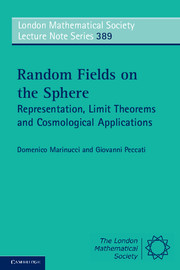Book contents
- Frontmatter
- Contents
- Preface
- 1 Introduction
- 2 Background Results in Representation Theory
- 3 Representations of SO(3) and Harmonic Analysis on S2
- 4 Background Results in Probability and Graphical Methods
- 5 Spectral Representations
- 6 Characterizations of Isotropy
- 7 Limit Theorems for Gaussian Subordinated Random Fields
- 8 Asymptotics for the Sample Power Spectrum
- 9 Asymptotics for Sample Bispectra
- 10 Spherical Needlets and their Asymptotic Properties
- 11 Needlets Estimation of Power Spectrum and Bispectrum
- 12 Spin Random Fields
- 13 Appendix
- References
- Index
8 - Asymptotics for the Sample Power Spectrum
Published online by Cambridge University Press: 07 October 2011
- Frontmatter
- Contents
- Preface
- 1 Introduction
- 2 Background Results in Representation Theory
- 3 Representations of SO(3) and Harmonic Analysis on S2
- 4 Background Results in Probability and Graphical Methods
- 5 Spectral Representations
- 6 Characterizations of Isotropy
- 7 Limit Theorems for Gaussian Subordinated Random Fields
- 8 Asymptotics for the Sample Power Spectrum
- 9 Asymptotics for Sample Bispectra
- 10 Spherical Needlets and their Asymptotic Properties
- 11 Needlets Estimation of Power Spectrum and Bispectrum
- 12 Spin Random Fields
- 13 Appendix
- References
- Index
Summary
Introduction
The primary goal of this monograph is to investigate the mathematical foundations of the analysis of spherical random fields, and because of this we neglect throughout this work a detailed discussion on practical data analysis. In this chapter, however, we do find it necessary to discuss some background issues on CMB data collection, as these topics are indeed useful for understanding the motivations of the techniques presented below.
As discussed earlier in the monograph, CMB (temperature) maps can be viewed as the single realization of an isotropic, scalar-valued spherical random field. Observations are provided by means of electromagnetic detectors (so-called radiometers and/or bolometers) which measure fluxes of incoming radiations (i.e. photons) on a range of different frequencies. For instance, the celebrated WMAP experiment is endowed with 16 detectors, centred at frequencies 40.7, 60.8 and 93.5 GHz, which are labelled the Q, V and W band, respectively. The ESA (European Space Agency) mission Planck (launched on May 14, 2009) is based upon 70 channels ranging from 30 GHz to 857 GHz. As the satellites scan the sky, observations are collected as a vector time series, the number of observations being in the order of 109 for WMAP and 5×1010 for Planck. A first issue then relates to the construction of spherical maps starting from the Time Ordered Data vector (TOD) provided by the satellite observations; this is the so-called map-making challenge, see for instance [109] and [45].
- Type
- Chapter
- Information
- Random Fields on the SphereRepresentation, Limit Theorems and Cosmological Applications, pp. 194 - 222Publisher: Cambridge University PressPrint publication year: 2011



